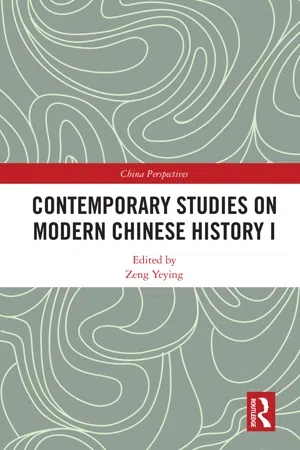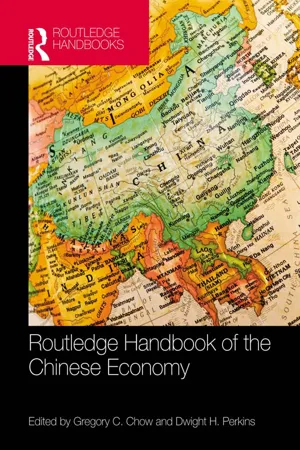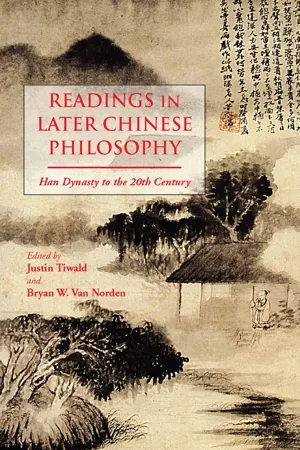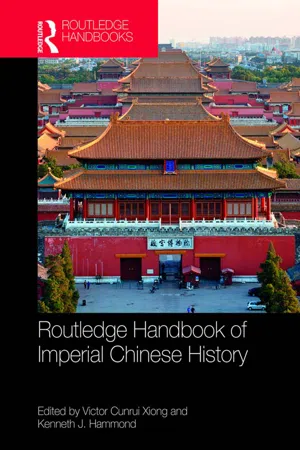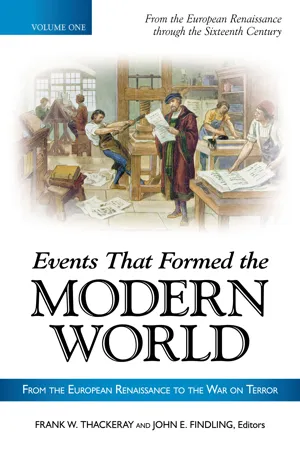History
Late Imperial China
Late Imperial China refers to the period from the Ming dynasty to the end of the Qing dynasty, spanning from the 14th to the early 20th century. This era was characterized by centralized imperial rule, economic growth, cultural flourishing, and significant social and political changes. It also saw the rise of European influence and the decline of the traditional Confucian-based social order.
Written by Perlego with AI-assistance
Related key terms
6 Key excerpts on "Late Imperial China"
- eBook - ePub
- F. W. Mote(Author)
- 2003(Publication Date)
- Harvard University Press(Publisher)
To be sure, the emperor, court, and central administration exerted very strong influence over the conduct of government throughout the realm, could control the official lives of the elite sector of society, and quite obviously held the decision-making power in policy matters. Yet there was much more to Chinese government, and to the lives of people throughout all of Chinese society. For all the dark shadows, the age of “High Qing” (as the eighteenth century has been dubbed) also has been painted in glowing colors: “It was an age of superlatives—the last brilliant epoch of the old Chinese imperial order.” 52 The descriptive information supporting that kind of generalization ranges from the elegant lives of the cultured elite, to the evidence for great wealth of cities throughout the realm, to the order and relative prosperity evident in much of the life of ordinary society. By the end of the Qianlong reign, the Qing state nevertheless faced many serious problems. The fiscal soundness of the later Qianlong reign period was undermined by military expenses (inflated by corrupt practices of military leaders), and by the inroads of insatiable civil officials led by the example of Heshen; the government began to run short of funds. A stodgy complacency affected the conduct of regional and local administration. Civil governing lagged behind changing social conditions. The aging ruler lost the discernment or the will to make the governing decisions that would have kept the machinery working better. Focused on enhancing the Manchu nobility’s status in society, he tolerated outrageous malpractice. In the view of his son and an impatient group of reform-minded officials, both Chinese and Manchus, the Qianlong emperor simply lived too long. He became more obstinate by the year. His son’s accession, when at last his father took up his symbolic retirement in 1796, was a frustrating sham that prolonged the emperor’s powers to reign - eBook - ePub
- Zeng Yeying, Zeng Yeying(Authors)
- 2020(Publication Date)
- Routledge(Publisher)
But modern Chinese history still has its basis, of which the political history of the late Qing Dynasty is still an important part. The reason is very simple: people need to know their yesterday and the day before yesterday, and the late Qing Dynasty is not far from us after all. What is more, since the Western Industrial Revolution in the late eighteenth century, the once backward West (including Western Europe, North America plus Japan in the East) has become the most advanced region in the world, and such a fundamental trend has remained substantially unchanged so far since the Western Industrial Revolution.The same late Qing Dynasty history looks somewhat different when it is observed in terms of modern history rather than in terms of dynastic history. From the perspective of dynastic history, the late Qing Dynasty is falling after the peak, the “end-time” or “declining years” after the “time of prosperity,” a “sinking history” or “dying history” of collapsing into decline. But the word “modern” itself is contrasted with “contemporary.” From the perspective of modern history, researchers focus on the reality and pay more attention to the formation and development of new forces and factors closely related to the reality. As Liu Danian pointed out, our study of modern history should reflect the past that is closely related to reality as people need to know in the development of the times. If we did not do this, it would be like the saying, “they are deaf people who answer questions that are never asked.”11The study of the political history of the late Qing Dynasty was most active in the period between the late 1970s and early 1980s. With the recovery and establishment of a number of research units and related disciplines in colleges and universities, with an increasing number of academic journals, and the convening of various small and medium-sized academic conferences, academic exchanges among scholars were unprecedentedly active, and a large number of papers and work were published. A few of these works were written in the early 1960s but were oversubscribed for various reasons. Some of the newly written works were accumulated research results during 1966 to 1976. - eBook - ePub
- Gregory C. Chow, Dwight H. Perkins(Authors)
- 2014(Publication Date)
- Routledge(Publisher)
2THE LATE QING DYNASTY TO THE EARLY REPUBLIC OF CHINAA period of great institutional transformation 1Kenneth S. ChanIn the period from the late Qing dynasty until the Republic of China, a far-reaching transformation in the social institutions of China took place. The traditional institutions and social values in the late Qing dynasty were unable to bring China out from the Malthusian trap into modern economic growth. Above all, it was the wars with – and defeats from – the imperialist nations that had brought China to this great institutional transformation. This chapter summarizes China’s response to the changing external environment in the Qing dynasty (the Republic of China) which was then under highly rigid and centralized (highly de centralized) institutions. Economic progress was observed in the early period of the Republic although, as the nation was fragmented, it never reached its full potential.Introduction
During the transition from the Tang to the Song dynasty in China, a major transformation of the social institution had taken place, in which China moved from a highly aristocratic society to a more populist society.2 The social values, such as cultural norms, social customs, and beliefs, also went through a sea change. However, an even more significant institutional transformation in China occurred in the period from late Qing to the Republic of China. This transformation had much more far-reaching implications than the one during the Tang–Song transition. The economic and social impact of the Qing–Republic institutional transformation will be the main focus of this chapter.This chapter is organized as follows. Section 1 summarizes some relevant theoretical economic models from the literature together with their predictions. By and large, these predictions receive support from the historical events. Section 2 describes the changing external environment and the economy in the Qing dynasty, governed under a highly centralized institution. Section 3 describes those in the Republic of China period when China was under a highly decentralized institution. Economic progress was observed in the period of the Republic, although it never reached its full potential, as the nation was fragmented (Rawski 1989). Section 4 sketches a version of the Malthusian and modern growth model that is relevant for the Chinese economy in this period. Section 5 - eBook - ePub
Readings in Later Chinese Philosophy
Han to the 20th Century
- Justin Tiwald, Bryan W. Van Norden(Authors)
- 2014(Publication Date)
- Hackett Publishing Company, Inc.(Publisher)
PART IV: LATE IMPERIAL CONFUCIANISM The beginning of the seventeenth century marks a shift away from Neo-Confucianism, both the orthodox form associated with Cheng Yi and Zhu Xi, and the less orthodox forms associated with Wang Yangming and others. None fell entirely out of favor, and in fact Cheng-Zhu thought continued to have a firm grip on the education system, as it was still necessary to memorize Zhu’s interpretations of the classics in order to pass the all-important civil service examinations. Nevertheless, China of the late Ming through the mid-Qing dynasties witnessed the rise of a new type of Confucian thinker, one who brought greater historical and philological rigor to his work and, consequently, suspected that Neo-Confucian interpretations of the great sages (especially Kongzi and Mengzi) had been distorted by Daoist and Buddhist ways of thinking. In Part IV, we look at the distinctive and new philosophical ideas and frameworks that emerged from this shift. Late imperial Confucianism was diverse, reflecting a more expansive sense of curiosity and openness to new ideas, but three trends stand out in this period. The first is the rise of statecraft (jīngshì). Prior to this period, mainstream Neo-Confucians were more interested in the character of those with political authority than in the finer points of how they wielded their power. As the Great Learning proclaimed, rulers must first “correct their minds” and “cultivate their selves” and only then can they “put their states in order.” 1 Once the mind was corrected and the self cultivated, specifying the policies to be implemented was no longer necessary, for the sage-like political leader could be counted on to exercise compassion and good judgment in his administration. By the seventeenth century, however, some Chinese philosophers decided that they could no longer wait for sages to appear - eBook - ePub
- Victor Cunrui Xiong, Kenneth Hammond, Victor Cunrui Xiong, Kenneth J. Hammond(Authors)
- 2018(Publication Date)
- Routledge(Publisher)
jiangxue fully devolve, from a force that empowered the many, to a force that empowered the few, to a force that empowered the one. If there is any sense in which the Ming dynasty seems to have fallen short of its promise, it is this one.Note
1 Chaves, Pilgrim of the Clouds , 39. Reproduced with the kind permission of White Pine Press.Passage contains an image
17CULTURAL HISTORY FROM THE YUAN THROUGH THE MING
Kenneth J. HammondThe cultural history of the Ming dynasty unfolds along a trajectory of revival and development, first in the reassertion of cultural hegemony by the Chinese literati elite in the wake of the fall of the Mongol Yuan dynasty, and then through a dialectic of transformation and persistence between the traditional concerns of literati intellectual and aesthetic production and the emergence of new modes of thought and artistic expression in the context of rapid expansion of the commercial economy and the social dynamism to which this contributed. Art, literature and thought all underwent significant changes in complex and sometimes contradictory movements. Toward the end of the dynasty, the intellectual and cultural sphere was further affected by the beginning of the period of ongoing contact and interaction between Europe and China, which brought ideas and information from Europe into sometimes fruitful interplay with established Chinese understandings and practices.The Yuan-Ming transition
For the Chinese literati, especially in the south, the era of Mongol rule was a time of marginalization and/or accommodation. In the realm of thought and in the arts the establishment of a single state governing the whole of Chinese territory after the long period of north-south division led to a renewed interaction between scholars, writers and artists across the empire. The flourishing of Confucian thought in the Daoxue 道學 movement, often referred to as Neo-Confucianism, which had characterized southern China in the twelfth and thirteenth centuries, had contrasted with the persistence in the north of intellectual concerns linking back to the Northern Song. While the Mongols called upon Chinese scholars in the north for assistance in the consolidation of their rule after the conquest of the Jurchen Jin state in 1234, southern literati were viewed with a much more jaundiced eye after the final extension of Yuan rule to the south in the 1270s. The suspension of the civil examinations until 1315 is perhaps the clearest sign of Mongol disregard for the Confucian elite and its intellectual and cultural concerns. Literati who did serve in official positions under the Yuan found themselves subject to supervision by non-Chinese overseers, the darughachi - eBook - ePub
Events That Formed the Modern World
From the European Renaissance through the War on Terror [5 volumes]
- Frank W. Thackeray, John E. Findling, Frank W. Thackeray, John E. Findling, Frank W. Thackeray, John E. Findling(Authors)
- 2012(Publication Date)
- ABC-CLIO(Publisher)
It is in this context that the Qing dynasty failed. It spent a great deal of its energy and resources on keeping traditional order and, with the assistance of the Chinese, the power of the central government was reinforced. Because its rule was so effective, it could resist early blows from the West; but this delayed any meaningful reform for a long time. Once the dynasty could no longer maintain its traditional ways, it went down quickly and sank to the bottom.Selected Bibliography
Cao Xueqin. Honglou Meng, The Story of the Stone (Dream of the Red Chamber) . 5 vols. Translated by David Hawkes and John Minford. Harmondsworth, United Kingdom: Penguin, 1973–1982. China’s greatest novel describes the decline of Qing society.Chang, Chun-shu, and Shelley Hsueh-lun Chang. Crisis and Transformation in Seventeenth-Century China: Society, Culture, and Modernity in Li Yu’s World . Ann Arbor: University of Michigan Press, 1991. A famous contemporary man of letters explores various aspects—state, society, economy, and culture—of the Ming-Qing transition.Ch’uT’ung-tsu. Local Government in China Under the Ch’ing . Cambridge, MA: Harvard University Press, 1962. The most comprehensive analysis of the Qing government at local levels.Esherick, Joseph W., and Mary Backus Rankin, eds. Chinese Local Elites and Patterns of Dominance . Berkeley: University of California Press, 1990. This collection of essays examines elites in Ming, Qing, and Republican China and challenges the common image of a uniform national gentry class.Harrell, Stevan, ed. Cultural Encounters on China’s Ethnic Frontiers . Seattle: University of Washington Press, 1995. Explores the effects of the “civilizing project” on the peripheral peoples; in the case of the Manchus, the conquerors of China and emperors of the Qing absorbed much Chinese culture while struggling to maintain their Manchu origins.Huang, Liu-Hung. A Complete Book Concerning Happiness and Benevolence: A Manual for Local Magistrates in Seventeenth-Century China
Index pages curate the most relevant extracts from our library of academic textbooks. They’ve been created using an in-house natural language model (NLM), each adding context and meaning to key research topics.

